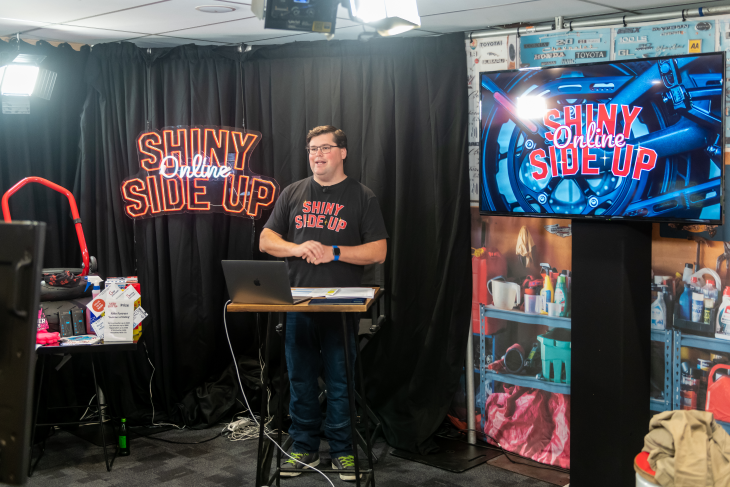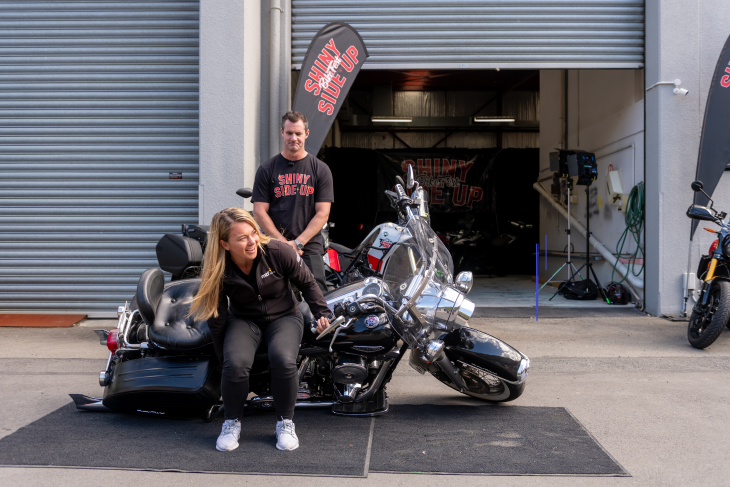Four things we learned at Shiny Side Up online

More than 3,000 riders in Aotearoa parked up their bikes on Sunday 10 April and tuned into 2022’s Shiny Side Up Online. Here’s the top four things they learned.
For the last six years, ACC’s Ride Forever, Waka Kotahi New Zealand Transport Agency and Motorcycle Safety Advisory Council (MSAC) bring motorcyclists in Aotearoa a series of free events under the Shiny Side Up banner.
The Shiny Side Up event series is about bringing experts and motorsport professionals to motorcyclists and teaching them tips and tricks. It also offers rider skill workshops, showcases of full protective gear and teaches riders about the latest technology in bike safety.
Usually, these events are a mix of outdoor "Bike Fests" together with smaller "Talk Series" events. Shiny Side Up aims to engage with riders, share information on riding and encourage them to enrol in the Ride Forever coaching programme.
Find a Ride Forever course in your area.
Learn more about Shiny Side Up
Unfortunately for 2022, COVID-uncertainty meant that the team had to put all their energy into hosting what is now New Zealand’s largest online event for riders. And thank goodness for us they did.
With 12 motorcycling gurus from across the globe sharing their stories, tips, tricks, and banter, it’s no surprise that the six hours was packed from start to finish with absolute gold.
Ray Heron and Jay Reeve expertly picked our speakers’ brains, including SuperBike world champion Carl Forgarty, Kiwi lad designer Ducatis in Italy, Sam McCafferty, motorcycle skills expert Kevin Williams and the scientist of great gear, Dr Chris Hurren.
If you couldn’t tune in, the recorded version is saved on the Shiny Side Up BikeFest Facebook page.
Watch Shiny Side Up Online 2022

Gals need gear too
The importance of gear is never understated in the motorcycling world. Good gear could be the difference between a minor annoyance and losing your life in a crash. As they say, dress for the slide and not for the ride.
But, finding good gear as a woman can be a lot harder than you might think.
Amber Urhle, track racer and advocate for women’s motorcycling gear, (known to her followers as Chaotic Blonde), says that it was difficult for her to know what women’s motorcycling gear she needed.
In fact, she even thought a leather jacket, pants, and boots from general clothing stores would be fine, because it was that hard to find gear guidance as a lady rider.
She spent lots of time researching online and reading reviews. This helped her to find out what women overseas do, and how that might be different for women in New Zealand.
The next step was for her to challenge the motorcycle stores around her to stock women’s riding gear. Not only did it have to fit well, it also had to be highly rated on MotoCAP, Dr Chris Hurren’s program that rigorously tests motorcycle gear for the Australian and New Zealand market.
Her advice to women in New Zealand is to continually push back on your local motorcycle stores to stock what you need. She says try not to buy gear online that you can’t try on, or at the very least, have a comparable size reference. Websites like MotoCAP are also very helpful for researching the best gear options for you.
Common crashes motorcyclists are having and how to avoid them
We learned that the injuries sustained by people who crash on their motorcycle cost around $130 million per year. This doesn’t include the emotional cost it can have on the riders or their whānau.
Around $28 million comes from through the motorcycle registration levy, but the rest comes from other road user levies.
Dave Keilty, Injury Prevention Partner at ACC, said the statistics also vary depending where you ride. In urban areas, the crash fault is an even split between car drivers, motorcyclists, and a mix of both. However, in rural areas, motorcyclists are at fault for a much larger 66% of crashes.
As Jay said on Sunday, it’s encouraging because “we can change that number, because that’s on us as riders”.
One way you can change that number is to get yourself some rider training with qualified professionals, and Ride Forever is the best place to start.
Book a Ride Forever course from $20
The panel at Shiny Side Up also spoke about some of the more common crashes they see, with their advice.
‘The Sarge’, Sgt. Peter Sowter, said that he sees a lot of motorcycles that have struck another vehicle. Sometimes because that vehicle pulled out, but also because of motorcycles running into the back of them. His advice is to check your following distance and give yourself time enough time to react. Don’t put yourself at risk by not giving yourself enough space.
Amber Urhle said that the crashes she sees are due to a lack of attention. She says she hears motorcyclists say “it’s everyone else’s fault” all the time. Her advice? “Go back to reality and think about the hazards around you. Everyone always says, “look out for those who want to kill you”, when really you should be looking out for your own hazards [first].”
Confidence – everybody has off days
When you think of motorcyclists, you think confidence. But, we learned that is definitely not always the case. All our motorcycling legends, even with their years of experience either recreationally or professionally, have had to deal with confidence wobbles.
Avalon Biddle, two-time World SuperBike champion, says that knowing your strengths and weaknesses is a good place to start. A good way to identify these is through some rider training, like a Ride Forever course.
The trainers are qualified and hugely experienced in helping you settle your nerves. They help you to work on the areas where you feel less comfortable in a no-pressure environment, even if that’s everything!
After accidents, it can be hard to pick yourself back up. Amber Urhle, Chaotic Blonde, said it took her a good four months before she felt confident enough to get back on the bike.
Her advice is to ensure that you’re around likeminded supportive people. Her first few rides were with friends, who understood what she was feeling and stayed by her side. She says, “Take baby steps, don’t worry! You’ll get your mojo back eventually.”

Picking up a bike
Another epic thing we learned at Shiny Side Up was how to pick up your bike if it ever falls over (without blowing your back out). This is unfortunately a common sight for many motorcyclists.
Avalon Biddle, stretching to a grand 153cm tall, told us things to look for before you even start:
- Check your side stand is out so that you don’t flip your bike over when you pick it up.
- Look for any fluids coming out of the bike. If there are, leave it and call for help. You don’t want to mix anything like petrol, oil or other motor fluids with a hot engine.
- Put your bike into gear as this stops the bike from moving around.
- If you don’t feel confident, call a friend for help.
As you go to pick up your bike, walk to the side that it’s fallen on, grab on to anything that isn’t going to move, and push the bike up with your legs.
Make sure to Have a Hmmm beforehand so that you don’t injure yourself!
We all had a great time at Shiny Side Up Online this year. If you or your friends and whānau are interested, you can watch the full event on the Shiny Side Up BikeFest Facebook page and give the page a follow for any updates on next year’s event series.




